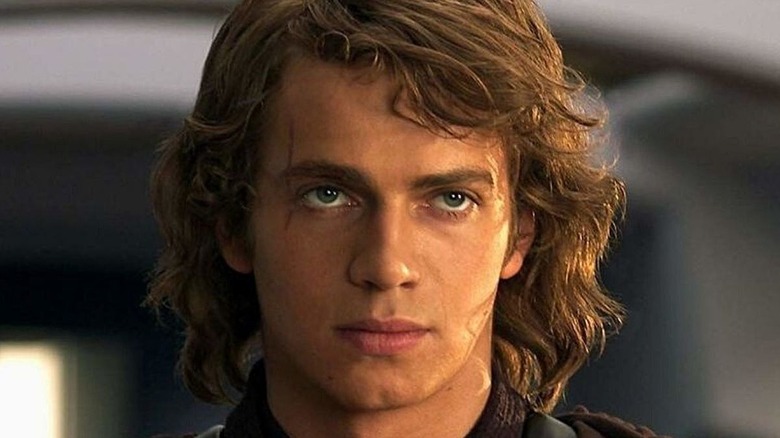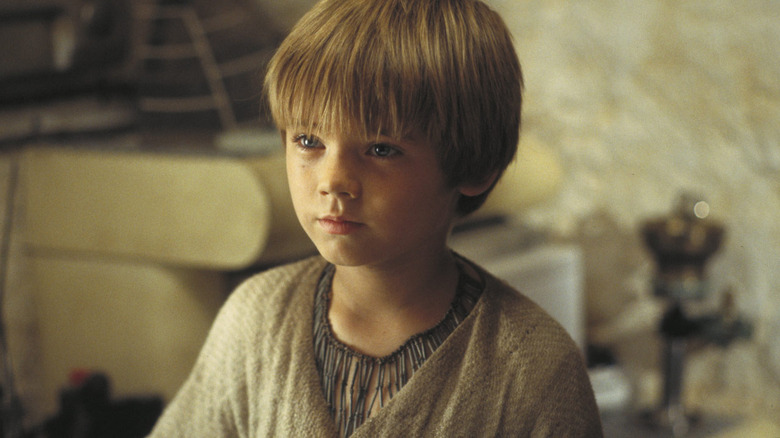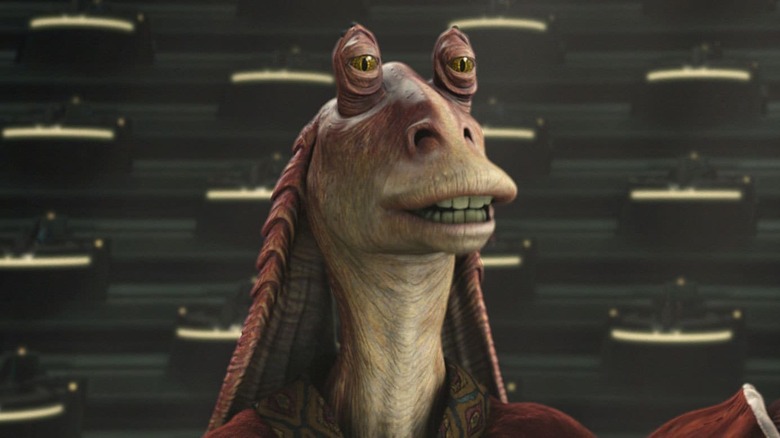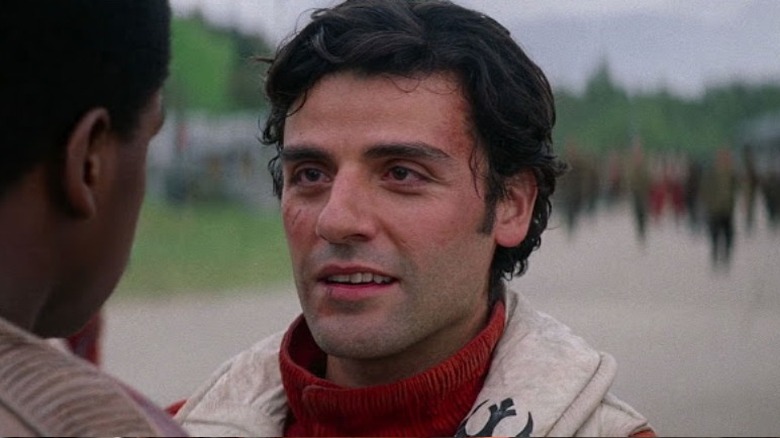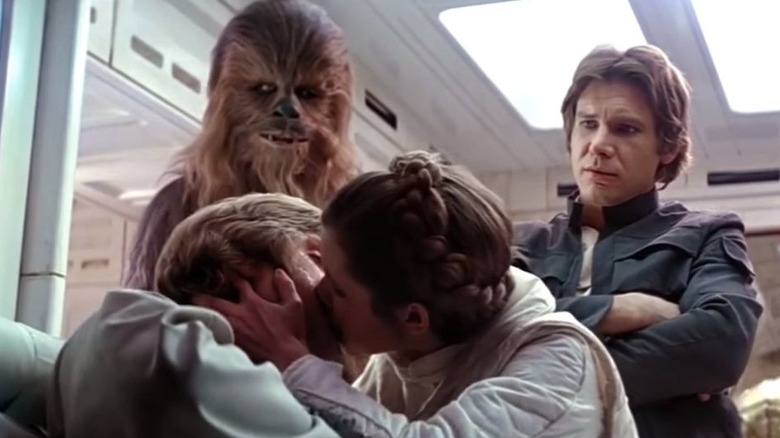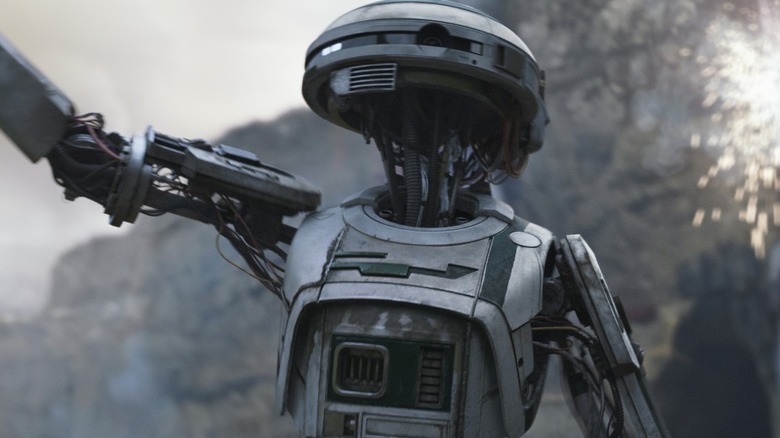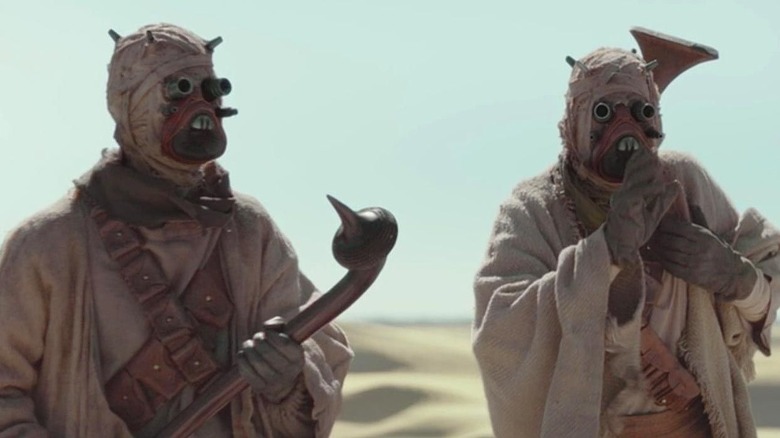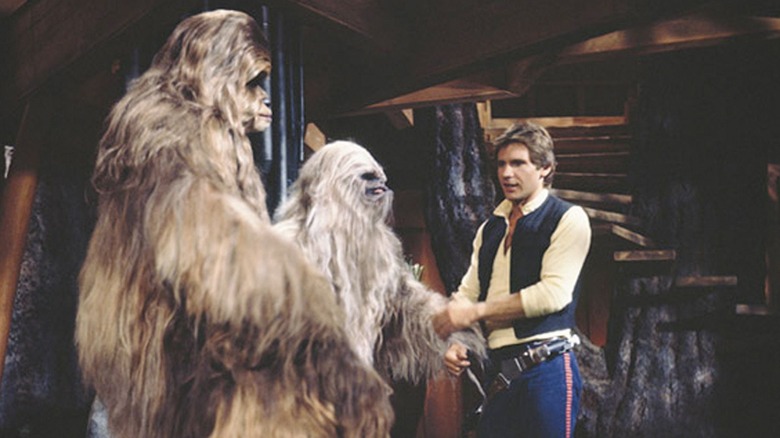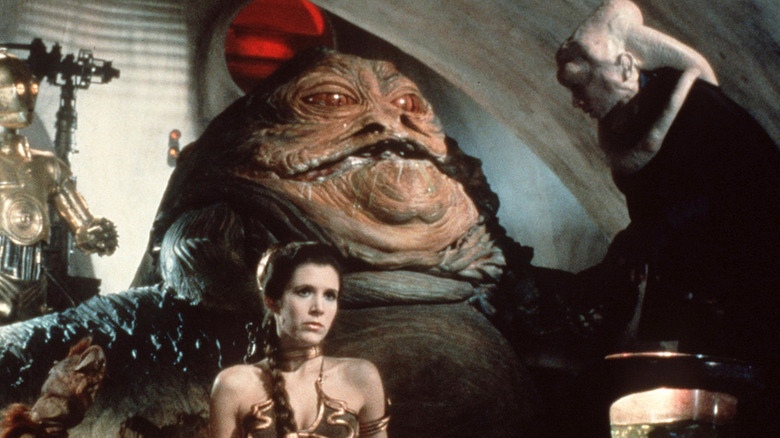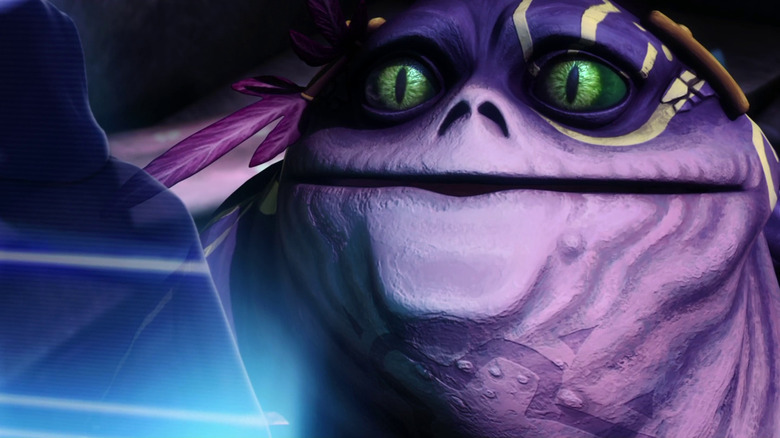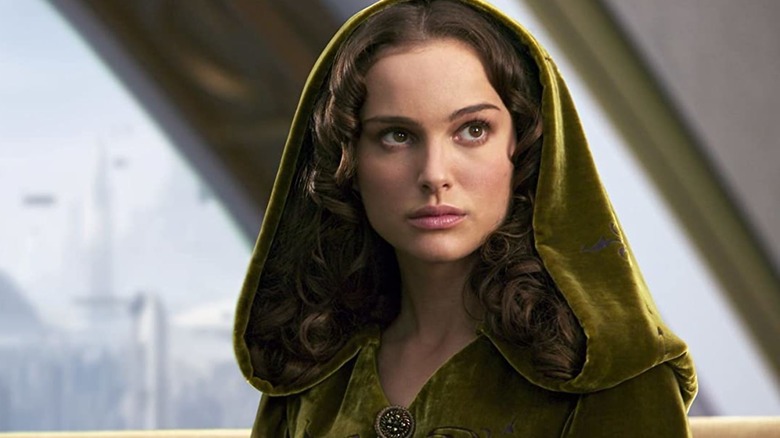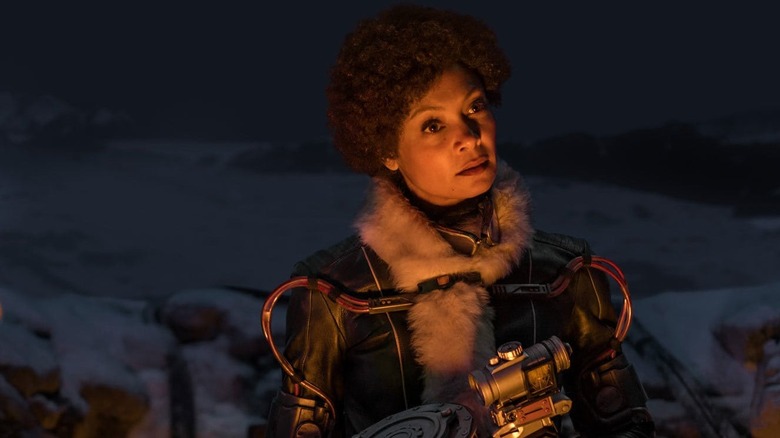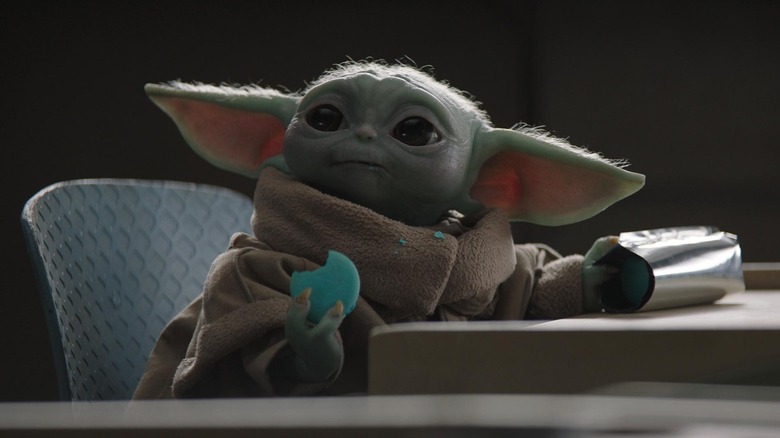Times Star Wars Went Too Far
The "Star Wars" franchise has offered audiences lots of thrilling escapism over the decades, with each new generation getting a collection of exciting new movies to call their own. However, the pervasive presence of "Star Wars" in global pop culture can't paper over the fact that, sometimes, this cosmic saga has messed up.
Not just in delivering subpar movies but also in highlighting moments that just went too far. It's one thing to deliver unorthodox storytelling choices, but there have been several instances where the "Star Wars" has dabbled in gags, dramatic beats, and even weighty themes that a series aimed at children just can't hope to properly portray. When you take notice of all those times the series exceeded its grasp, you can clearly see where the "Star Wars" franchise has crossed a line.
Such instances are spread all across the "Star Wars" media landscape and range from the most famous "Star Wars" films to obscure titles like "The Star Wars Holiday Special." Just as there are countless examples of unforgettable fun across these tales of good and evil, there are also lots of moments that proved distracting when they went too far.
The Phantom Menace introducing slavery
There are some real-world situations that blockbuster franchises shouldn't even try to approach. That's not because these franchises are inherently incapable of handling any weighty themes. It is more that certain concepts are just too grim to be introduced into media aimed at children without disrupting the entire escapist aesthetic of the production. "The Phantom Menace" is a great example of this phenomenon, as this movie decided that what "Star Wars" really needed wasn't just a new spaceship and a cool new lightsaber. Instead, as part of adolescent Anakin Skywalker's backstory, slavery was introduced as a foreground element of the "Star Wars" mythos.
In a movie containing fart gags and big space battles, the true horrors of slavery just can't be appropriately represented. It ends up serving as a distraction for all future escapades in the "Star Wars" prequel trilogy. With slavery established as not just existing, but being common, the rest of the lore in this trilogy feels like small potatoes. Who cares about the planet Kamino being erased from the Jedi archives when people are still being enslaved on planets across the galaxy? Right from the start of this collection of films, the prequel trilogy went way too far in establishing slavery in a franchise that just isn't capable of exploring this concept in an appropriate fashion.
Racial stereotypes in The Phantom Menace
Before the prequel trilogy, the aliens in "Star Wars" weren't devoid of racially stereotypical behavior (hi Nien Nunb!), but it wasn't as aggressively apparent in this galaxy far, far away. That all changed within minutes of "The Phantom Menace," as noted by multiple news outlets at the time.
First, the Los Angeles Times observed that Nute Gunray speaks in an accent that, charitably speaking, sounds like it resembled a caricature of an Eastern accent. It is all downhill from there, as a trip to Naboo sees Jar-Jar Binks waltzing onto the screen, sounding like what The Baltimore Sun likened to an unfortunate combination of minstrel and Rastafarian stereotypes. Slate notes that leaving Naboo doesn't help matters, as viewers soon meet a potentially anti-Semitic stereotype in Watto, who flies around talking about his love for money.
Classic aliens in the "Star Wars" franchise made you want to buy their action figures. The aliens in "The Phantom Menace" largely reminded moviegoers of ugly racial stereotypes from Earth, but without any commentary or subversion to justify their presence. While the two later entries in the prequel trilogy toned things down a bit, the recurring presence of characters like Watto and Jar-Jar Binks across these movies kept this puzzling element alive. There are limitless possibilities when crafting new Star Wars aliens, so it's bizarre that the prequel trilogy took things too far by designing aliens around lazy racial stereotypes.
Poe Dameron's backstory in The Rise of Skywalker
For the first two entries in the sequel trilogy of "Star Wars" movies, Poe Dameron was a cocky pilot who had the ceaseless charisma of Oscar Isaac and a character arc revolving around learning how to listen to others. These were all already enough to make Dameron a fan-favorite character, but "The Rise of Skywalker" decided to cap off the trilogy by injecting something nobody asked in a racially insensitive backstory (via Daily Dot). This movie reveals that Dameron used to run as the "Star Wars" equivalent of a drug dealer before joining the Resistance to dish out justice against The First Order. Meant to be a way of explaining why Dameron had a connection to Zorii Bliss, this new detail mostly just provided glaring problems.
It's unspeakably tone-deaf to make the first prominent Latinx character in "Star Wars" media any sort of drug dealer, given how that's the sort of role Latinx performers are often relegated to in mainstream media. It also doesn't do much to enhance the character of Dameron as he was already a well-defined character. It's just a pointless attempt to add further dimensions to Poe Dameron that end up playing into harmful racial stereotypes. Oscar Isaac and general moviegoers alike deserve better.
That Luke/Leia kiss in The Empire Strikes Back
There's a kiss at the start of "The Empire Strikes Back" that, to quote Franklin D. Roosevelt, "will live in infamy." After Luke Skywalker is rescued from the clutches of Hoth's cold weather, this young Jedi is resting up and talking to his pals, including Han Solo and Leia Organa. This discussion eventually dovetails into an argument between Organa and Solo concerning the possibility of Leia harboring secret romantic attractions to this scoundrel. To prove that Solo doesn't "know everything about women yet," Organa proceeds to plant a big smooch on Skywalker's lips, causing this recently rescued individual to smirk with pride once the burst of romantic passion is over.
In the grand scheme of "Star Wars" lore, it's apparent why this scene goes too far given that Skywalker and Organa are siblings separated at birth. In defense of "The Empire Strikes Back," that piece of lore wasn't defined yet when the film was in production, with George Lucas initially even planning to have Luke's sister be a new character (via Esquire). Still, as part of a sprawling saga, the greater context of the duo's relationship makes this moment squirm-inducing rather than its initial intent of registering as just humorous. No wonder this kiss has been burned into the minds of "Star Wars" fans for all the wrong reasons!
L3's consciousness getting uploaded into the Millennium Falcon
Throughout her screentime in "Solo: A Star Wars Story," L3-37 is all about giving droids autonomy and freeing them from their human masters. This passion comes to a head on a Kessel mine mission, where she leads a droid revolution just before getting shot and killed in the heat of battle. Here, it appears that L3's storyline has come to an end — but "Solo" isn't finished with this character just yet.
Shortly afterward, L3's consciousness is uploaded to the Millennium Falcon, a development L3 has no say in and that all her previous actions suggest she would be vehemently against. It's a conclusion to her storyline that's meant to make the audience happy seeing how Lando's robot pal is now inside Lando's ship. However, it only serves to give L3 a send-off that undermines her sole notable character trait. It also apparently retcons a line by C-3PO from "The Empire Strikes Back" to explain where the Falcon got its "peculiar dialect."
Does that mean a potentially interesting supporting character has to get undercut just to explain a piece of dialogue that doesn't really require any explanations in the first place? Confusing instances of screenwriting abound in "Solo," but the treatment of L3 here takes things to a whole new level.
The slaughtering of Tusken Raiders in Attack of the Clones
In "Attack of The Clones," Anakin Skywalker's descent to the dark side of the Force begins when he sneaks into a Tusken Raider camp and finds his mother dying from extreme injuries. After they share one final goodbye before she passes away, Skywalker looks up from her corpse, enraged. He then bursts out of the tent she was held in and slices down a Tusken Raider. The screen cuts to black, but Skywalker later informs Padme Amidala that, in an act of rage and revenge, he killed all of the Tusken Raiders on the premises, including "the women. And the children, too!"
The trajectory of the prequels trilogy means that Anakin Skywalker has to grow more and more nefarious as these movies move along. It was only inevitable that one of these features would contain a sequence where Skywalker commits some unspeakable act of violence. However, as executed here, Skywalker's vicious revenge goes a bit too far, mostly because there's never a moment for "Attack of the Clones" to properly process the gravity of this event. The story has to get Skywalker and Amidala off to Geonosis for the climactic battle, which rushes through both the characters and the audience while processing this grave deed. Though it makes sense in his character arc, the slaughtering of the Tusken Raiders is clumsily executed enough to undercut its important intent.
That VR scene in The Star Wars Holiday Special
One of the many disturbing moments in "The Star Wars Holiday Special" concerns Chewbacca's grandfather, Itchy, getting strapped into a virtual reality machine. Once properly seated, he proceeds to watch a seductive song and dance routine from Diahann Carroll, who even whispers seductive phrases to the Wookiee. While this sequence is playing out in the machine, the camera keeps cutting back to an extremely excited Itchy. Like so many parts of this special that don't work, this segment with Itchy and the VR machine stretches on and on. As it continues, the seedy undertones of the proceedings become more apparent by the minute.
The problems of this scene are many, but the biggest issue is how the underlying adult nature isn't subtext. It practically rubs in your face the explicit nature of the programming Itchy is enjoying. What truly exemplifies this moment as an example of "Star Wars" going too far is how it doesn't fit into the rest of the special. There's nothing wrong with overt depictions of sensuality, but it feels odd to do that here, in a holiday special that otherwise doesn't linger on it. It'd be like throwing a random scene of violence into a sultry cabaret performance. Most importantly, this program is aimed at children, making the scene's presence extra confounding. If this is what you want out of "Star Wars" entertainment, enjoy Itchy's weird VR exploits. Otherwise, skip this egregious sequence.
That chain bikini in Return of the Jedi
Once Leia Organa is captured by the nefarious crime lord Jabba the Hutt, this space slug proceeds to dress the princess up in a chain bikini reminiscent of the outfit worn by a recently deceased Twi'lek dancer. Organa proceeds to wear the costume for the majority of "Return of the Jedi's" first act. It isn't until the action shifts off the planet of Tattoine that she gets a new costume. Though Organa didn't don this bikini again in "Return of the Jedi," this costume quickly became an iconic piece of imagery that was common in cosplay circles and merchandising.
The latter use of the chain bikini costume is downright disturbing given how Organa had no say in wearing this outfit, as she is forced to do so by Jabba the Hutt. However, Lucasfilm merchandising had no problem taking this image and putting it on posters, T-shirts, and other apparel. Esquire reports that the dissonance between the costume's meaning in "Return of the Jedi" became so pervasive that Lucasfilm, shortly after Disney absorbed the company, even agreed to stop producing merchandise featuring this attire. At least this decision eased up the prominence of this moment in "Star Wars" that went too far.
Zirro the Hutt is a gay stereotype
A little more than halfway into the 2008 movie "Star Wars: The Clone Wars," audiences meet a new character in Zirro the Hutt. A crimelord like the much more famous character Jabba the Hutt, there are a few key differences between Zirro and Jabba. For one thing, Zirro speaks perfect English. For another, he's got the voice of Truman Capote and is covered in purple skin. The combination of a flamboyant voice and that skin color (purple is often associated with the LGBTQIA+ community) makes it clear that Zirro the Hutt is a gay stereotype of the sort that might appear in the classic Hollywood films "Star Wars" draws inspiration from.
There's nothing inherently wrong with having a villain character whose incidentally gay, but it is strange to lean on such broad queer stereotypes as a way of defining your antagonist. This becomes even more recognizable in a franchise as devoid of nuanced queer representation as "Star Wars." It doesn't help that Zirro's character traits stemming from queer stereotypes feel like they exist to make heterosexual viewers giggle out of mockery rather than a noble, if misguided, attempt at diversity. While he may be one of the brand-new characters introduced in the "Star Wars: The Clone Wars" feature, Zirro is also an unfortunate relic of when flamboyantly evil queer villains were common in children's entertainment.
The awkward death of Padme
Padme Amidala is nowhere to be seen in the original trilogy of "Star Wars" movies from the 1970s and 1980s. Thus, it is only a matter of time before the lone prominent lady character in the prequel trilogy is either killed off or otherwise pushed to the sidelines. Even with everyone aware of this inevitability, however, it was still shocking how "Revenge of the Sith" chose to dispose of the then-pregnant Amidala. After a confrontation with her husband, Anakin Skywalker, on the planet Mustafar, Amidala is Force choked by Skywalker. Shortly after, a medical droid notes that they can save the babies, but Amidala herself is dying for inexplicable reasons.
Perishing shortly after she informs Obi-Wan Kenobi that Anakin still has "good in him," Amidala's primary purpose of birthing Luke and Leia is complete. All that's left is for her to be given an extravagant funeral. It's a strange whimper of a conclusion for the character, especially since it contradicts how Leia states that she can remember her in "Return of the Jedi." There was pre-established lore that could've allowed an easy out to avoid killing off Amidala. Instead, "Revenge of the Sith" goes too far in killing off the only notable lady in these origin films and gets rid of her in a bizarre fashion to boot.
The fridging of Val in Solo: A Star Wars Story
In "Solo: A Star Wars Story," history was made with the introduction of Val (Thandiwe Newton), the most prominent Black woman to exist in live-action "Star Wars" media up to that point. Introduced a clever rogue married to Tobias Beckett (Woody Harrelson), the character doesn't last long in "Solo." During a heist gone awry, Val is one of two close allies to Beckett that ends up perishing. Sacrificing herself to ensure that the mission can be finished properly, Val dies. The first major set-piece in "Solo: A Star Wars Story" isn't even finished yet, and a promising character is already out the door.
Given that this development exists solely to motivate Beckett's subsequent actions, the demise of Val can't help but feel like a classic example of fridging. Fridging, as explained by Vox, is a narrative device that sees a female character die to motivate the story's protagonist. This tiresome narrative staple feels especially out of place in a "Star Wars" movie, given how often this franchise has been all about subverting expectations rather than giving in to them.
The lack of other Black women in "Star Wars" also makes this death extra disappointing, with Newton commenting on this subtext in an interview with Inverse a few years after "Solo" hit theaters. Val could've been a landmark "Star Wars" character, but instead, she was a disappointing example of how little notice Black women get in this franchise.
The controversial sight of Baby Yoda eating those eggs
Everybody loves Grogu, aka Baby Yoda. Fans make memes about him, t-shirts featuring his adorable mug are everywhere, he's even gotten his own Macy's Thanksgiving Day parade float. However, that doesn't mean Grogu is devoid of controversy in the "Star Wars" franchise. One Season 2 episode of "The Mandalorian" features Grogu scarfing down the eggs of their frog alien passenger. While the titular lead of "The Mandalorian" tells Grogu to knock it off, this baby is always eyeballing the canister containing the eggs.
Meant as a dark gag, fans did not respond well to Grogu's egg consumption which, in effect, reduces the population of this already struggling alien species to even lower numbers. A brief backlash occurred that proved so loud that Insider reports that a creative arts manager at Lucasfilm put out a response defending the youngster's actions by comparing the frog eggs to chicken eggs. Of course, the controversy didn't last long and people were soon back to making GIFs out of adorable bits of physical comedy from Grogu. However, this character's controversial approach to satisfying his hunger shows that any "Star Wars" character, even fan-favorites, can end up going too far.
